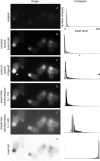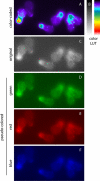Not seeing is not believing: improving the visibility of your fluorescence images
- PMID: 22379119
- PMCID: PMC3290635
- DOI: 10.1091/mbc.E11-09-0824
Not seeing is not believing: improving the visibility of your fluorescence images
Abstract
The digital age has brought both technical advances and ethical quandaries regarding data acquisition and image presentation in the field of cell biology. Image manipulation has drawn considerable attention in the past decade, leading to general guidelines for ethical data processing. However, effective methods of image presentation have been discussed only cursorily and have been largely overlooked. Under standard viewing conditions, the human visual system imposes limitations for readers analyzing fluorescence images. In this paper, I discuss the advantages and limitations of image-manipulation techniques with respect to the human visual system, including contrast stretching, nonlinear grayscale transformations, and pseudocoloring. While online data viewing presents innovative ways to access image information, most images continue to be viewed in static publications, in which image presentation is critical for effective information transmission.
Figures


Similar articles
-
Seeing Your Way to New Insights in Biology.J Mol Biol. 2019 Jun 28;431(14):2485-2486. doi: 10.1016/j.jmb.2019.04.033. Epub 2019 Apr 26. J Mol Biol. 2019. PMID: 31034886 No abstract available.
-
Technical review: types of imaging-direct STORM.Anat Rec (Hoboken). 2014 Dec;297(12):2227-31. doi: 10.1002/ar.22960. Epub 2014 Jul 4. Anat Rec (Hoboken). 2014. PMID: 24995970 Review.
-
Interpreting CARS images of tissue within the C-H-stretching region.J Biophotonics. 2012 Oct;5(10):729-33. doi: 10.1002/jbio.201200104. Epub 2012 Jul 20. J Biophotonics. 2012. PMID: 22815249
-
Digital image processing: a primer for JVIR authors and readers: part 2: digital image acquisition.J Vasc Interv Radiol. 2003 Nov;14(11):1365-72. doi: 10.1097/01.rvi.0000103181.99891.dd. J Vasc Interv Radiol. 2003. PMID: 14605101
-
Digital cytology: current state of the art and prospects for the future.Acta Cytol. 2011;55(3):227-38. doi: 10.1159/000324734. Epub 2011 Apr 27. Acta Cytol. 2011. PMID: 21525733 Review.
Cited by
-
Reproducible image handling and analysis.EMBO J. 2021 Feb 1;40(3):e105889. doi: 10.15252/embj.2020105889. Epub 2021 Jan 22. EMBO J. 2021. PMID: 33480052 Free PMC article.
-
A beginner's guide to rigor and reproducibility in fluorescence imaging experiments.Mol Biol Cell. 2018 Jul 1;29(13):1519-1525. doi: 10.1091/mbc.E17-05-0276. Mol Biol Cell. 2018. PMID: 29953344 Free PMC article.
-
Isolation and quantitative immunocytochemical characterization of primary myogenic cells and fibroblasts from human skeletal muscle.J Vis Exp. 2015 Jan 12;(95):52049. doi: 10.3791/52049. J Vis Exp. 2015. PMID: 25650991 Free PMC article.
-
Characterization of Antibodies against Receptor Activity-Modifying Protein 1 (RAMP1): A Cautionary Tale.Int J Mol Sci. 2022 Dec 16;23(24):16035. doi: 10.3390/ijms232416035. Int J Mol Sci. 2022. PMID: 36555690 Free PMC article.
-
Myeloid SOCS3 Deficiency Regulates Angiogenesis via Enhanced Apoptotic Endothelial Cell Engulfment.J Innate Immun. 2020;12(3):248-256. doi: 10.1159/000502645. Epub 2019 Oct 1. J Innate Immun. 2020. PMID: 31574508 Free PMC article.
References
-
- Brown C. Fluorescence microscopy—avoiding the pitfalls. J Cell Sci. 2007;120:1703–1705. - PubMed
-
- Cataliotti J, Gilchrist A. Local and global processes in surface lightness perception. Percept Psychophys. 1995;57:125–135. - PubMed
-
- Gonzalez R, Woods R. Digital Image Processing. 3rd. Upper Saddle River, NJ: Prentice Hall; 2008.
-
- Hill E. Announcing the JCB DataViewer, a browser-based application for viewing original image files. J Cell Bio. 2008;183:969–970.
-
- Mollon JD. Color vision. Annu Rev Psychol. 1982;33:41–85. - PubMed
MeSH terms
LinkOut - more resources
Full Text Sources
Other Literature Sources
Miscellaneous

